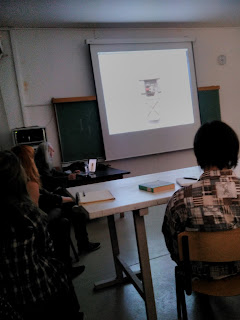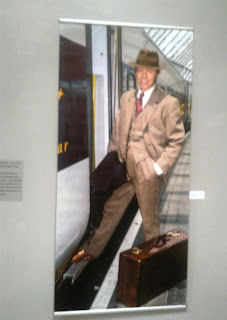He was born in 1942 in Milwaukee, Wisconson to German parents and has made over fifty films, mostly documentaries, during his long career.
Benning became politically conscious in the late 1960's and took part in civil rights marches in Milwaukee, which was segregated at the time. He graduated with an MFA from the University of Wisconsin at the age of 33 and spent a number of years teaching there and in Northwestern University, The University of Oklahoma, and the University of California. He has been teaching film/video in the California Institute of the Arts since 1994.
Benning spoke about his work in general and also his current project, Untitled Fragments, which is a series of multi-media installations that examine four major events in American history - The Kit Carson's scorched earth policy that pushed the Navajo Indians from their homeplace of Canyon de Chilly in the 1860's; The 1967 execution of Che Guevara in Bolivia in 1967; The carpet bombing by the US military of Hanoi in 1972 by B52 bombers and the cedar fire in the Californian Sierras in 2016. He discussed how he wanted to write a text, make video recordings and create two and three dimensional art pieces based on these historical happenings and to somehow demonstrate links with all events through this installation.
Benning examines how US government policy and policies worldwide affecting climate change were the common underlying cause of these violent events which displaced and slaughtered thousands of people and resulted also in the destruction of vast swathes of the natural environment. The work includes video clips and sound recordings, old photographs and film footage [including one very poignant piece on the dead body of Che Guevara], a tapestry that depicts the dead body of Che, paintings he created using photos of the burned landscape in the Sierras which took months to create and which he then burned in a controlled fire himself . Also part of the work is a declassified radio transmission recording of a discussion by US Air Force pilots on the evening of the 26th December, 1972 during the bombing of Hanoi, paintings, arial photographs of the burnt area of the Californian Sierras and historical artefacts including copies of a number of Emily Dickenson's envelope poems and a paper wasp's nest which allude to the notion of being forcefully driven out of one's home.
One chilling moment was the conversation between the US pilots in 1972 where they chat about coming out safely from the mission themselves but with no regard whatsoever for the welfare of the unsuspecting people they're killing with bombs.
Benning outlines the cause and effect of government policy on migration and climate change when he reveals the cause of the cedar fire in California last year when a Mexican migrant worker drove his run-down car into the forest and it got got stuck. He had to leave it there and Benning outlined the chain of events that led to the fire starting,- the poverty of the man to be unable to afford a decent vehicle, the hotter climate and warmer winters which in turn led to the prevalence of a species of beetle in the Sierra Nevada which attacks trees from within that in turn renders them fragile and less able to resist fires. The aerial photographs clearly outline the damage wreaked by this fire. Benning displays this and he also took photographs of the burnt out car and removed the alternator from it. He displays this alongside a copy of the criminal complaint form issued by the police against the man charged with starting the fire.
In another installation segment, the Indian activist, John Tredell who died last year, can be heard in a recording talking about his work for the civil rights of native American Indians. He relates the story of the murder of his wife and child when his house was burned down by racists. But he insisted that he would not become who his oppressors wanted him to be, and fought against the notion that Indians should evolve into white men.
The whole project is a fascinating amalgam of fragments - as the title suggests, relating a web of inter-related incidents, with fire as the dominant destructive force, through the considered and poignant use of historical artefacts and items recording all these events.
Benning discussed other projects he instigated during his career including the 2 Cabins project. He bought two small cabins in the Sierra Nevada rebuilt them on the models of Henry David Thoreau and Ted Kaczynski's [aka the Unabomber] cabins. He made a number of films using these buildings as locations including Two Cabins and Nightfall and he also made a number of recordings of himself reading from Kaczynski's manifesto. Benning was exploring the concept of living alone with nature and the effects of solitude on the spirit.
It was an absorbing lecture and probably a rare chance to meet and listen to such an iconic filmaker and activist. As a result I have seen one of Benning's films, Landscape Suicide, a disturbing commentary on the American lifestyle where he explores the case of two murderers - Ed Gein a serial murderer during the 1950's and Bernadette Prott who murdered her friend in 1986. I intend to explore other work.































































